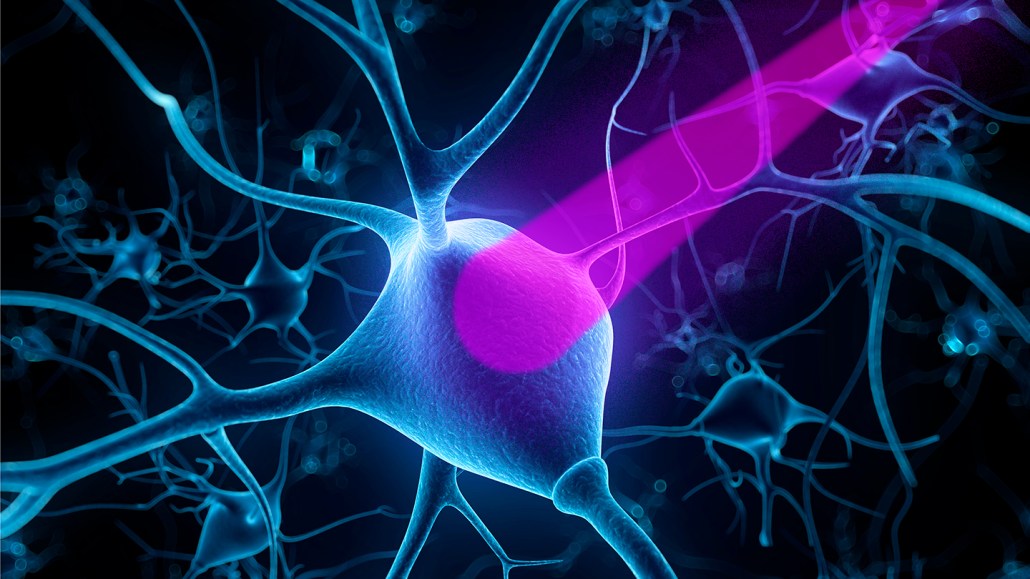Controlling nerve cells with light opened new ways to study the brain
A method called optogenetics offers insights into memory, perception and addiction

Optogenetics turns nerve cells into light-controlled puppets.
SEBASTIAN KAULITZKI/Science Photo Library/Getty Images, adapted by E. Otwell
- More than 2 years ago
Some big scientific discoveries aren’t actually discovered. They are borrowed. That’s what happened when scientists enlisted proteins from an unlikely lender: green algae.
Cells of the algal species Chlamydomonas reinhardtii are decorated with proteins that can sense light. That ability, first noticed in 2002, quickly caught the attention of brain scientists. A light-sensing protein promised the power to control neurons — the brain’s nerve cells — by providing a way to turn them on and off, in exactly the right place and time.
Nerve cells genetically engineered to produce the algal proteins become light-controlled puppets. A flash of light could induce a quiet neuron to fire off signals or force an active neuron to fall silent.
“This molecule is the light sensor that we needed,” says vision neuroscientist Zhuo-Hua Pan, who had been searching for a way to control vision cells in mice’s retinas.
The method enabled by these loaner proteins is now called optogenetics, for its combination of light (opto) and genes. In less than two decades, optogenetics has led to big insights into how memories are stored, what creates perceptions and what goes wrong in the brain during depression and addiction.

To celebrate our upcoming 100th anniversary, we’re launching a series that highlights some of the biggest advances in science over the last century. For more on the past, present and future of neuroscience, visit Century of Science: Our brains, our futures.
Using light to drive the activity of certain nerve cells, scientists have toyed with mouse hallucinations: Mice have seen lines that aren’t there and have remembered a room they had never been inside. Scientists have used optogenetics to make mice fight, mate and eat, and even given blind mice sight. In a big first, optogenetics recently restored aspects of a blind man’s vision.
An early clue to the potential of optogenetics came around 1 a.m. on August 4, 2004. Neuroscientist Ed Boyden was in a lab at Stanford, checking on a dish of neurons that possessed a gene for one of the algal light sensors, called channelrhodopsin-2. Boyden was going to flash blue light on the cells and see if they fired signals. To his amazement, the very first cell he checked responded to the light with a burst of action, Boyden wrote in a 2011 account. The possibilities raised by that little spark of activity, described in a 2005 technical report by Boyden, Karl Deisseroth of Stanford University and colleagues, quickly became realities.
In Pan’s lab, light-responsive proteins restored vision in mice with damaged retinas, a finding that has now led to a clinical trial in people. Optogenetics’ promise wasn’t a given in those early days, as scientists were first learning how to use these proteins in neurons. “At that time, no one anticipated that this optogenetic work would have such a huge impact,” Pan says.
Since those early discoveries, the algae’s light sensors have been adopted for use in numerous brain research arenas. Neuroscientist Talia Lerner of Northwestern University in Chicago, for example, uses optogenetics to study connections between cells in the mouse brain. The method allows her to tease apart the relationships between cells that produce and respond to dopamine, a chemical messenger involved in movement and reward. Those cellular links, illuminated by optogenetics, might help reveal details about motivation and learning. “My research really wouldn’t be possible in its current form without optogenetics,” she says.
Optogenetics is also indispensable for Jeanne Paz of the Gladstone Institutes in San Francisco. She and her colleagues have been hunting for the cells that can stop seizures from spreading across the brain. By giving her a way to control distinct groups of neurons, optogenetics is crucial to her search. “We really could not ask these questions with any other tool,” Paz says.
Sign up for our newsletter
We summarize the week's scientific breakthroughs every Thursday.
Her optogenetics-aided search led Paz to a brain structure called the thalamus, a way station for many neural networks in the brain. “I remember the goose bumps I experienced the first time I shined the light into the thalamus and it stopped the seizure,” she says.
So far, optogenetics research has taken place mostly in mice. But insights into more complex brains, including those of primates, may soon be found, says Yasmine El-Shamayleh of Columbia University. In 2009, Boyden and colleagues described optogenetics in a macaque. El-Shamayleh and others are pushing this line of research, hard. “We are definitely on the cusp” of revealing some fascinating principles of the primate brain, such as how the brain transforms signals from the eyes into perceptions, she says.
Optogenetics has evolved quickly. Scientists have engineered and optimized new light sensors and new ways of combining them with other techniques. An important reason for today’s widespread innovation, says Lerner, was the early spirit of sharing by optogenetics pioneers. At Stanford, Deisseroth would regularly run workshops to train other scientists on the technique. “In some ways, that’s as important as inventing it,” Lerner says.
So it’s worth taking a minute to appreciate the original sharers. No matter what happens next in this swiftly moving field, one thing is certain: Brain scientists will be forever in the algae’s debt.







